Electricity - 2.2.2 Series and Parallel Circuits (GCSE Physics AQA)
Series and Parallel Circuits
Series and Parallel Circuits
There are two main types of circuits:
- Series circuits – in a series circuit, all components are connected in line with each other.
- Parallel circuits – in parallel circuits, the components are connected in separate loops.
Some circuits can have both series and parallel parts.
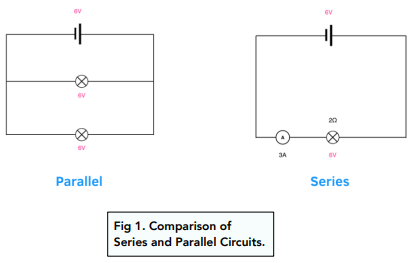
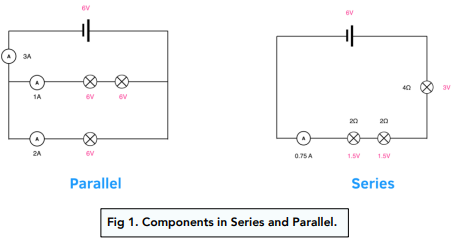
Series Circuits
In a series circuit, there are a few rules that we need to remember.
- Current is the same in all parts of the circuit. You can calculate the current by dividing the total voltage of the battery or cell by the total resistance in the circuit. Current is not ‘used up’ along the circuit.
- Total voltage is shared amongst components. The total voltage from the battery / cell is shared between the components – if the battery or cell provides 5V of energy, and there are two lamps (with equal resistance), each lamp will get 2.5V.
- Total resistance is the sum of the resistances of all components. Current needs to be the same everywhere, so the higher the resistance of an individual component, the greater its share of the voltage (so that current, which is voltage / resistance, stays equal). Therefore if you add an extra lamp to a series circuit, the total resistance increases and hence the current decreases. All lamps become dimmer. We can use the following equation to work out the total resistance in a series circuit:
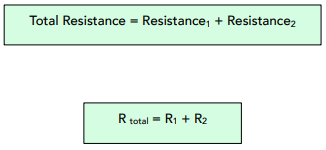
Where:
- Resistance, R, in ohms, Ω
- Cell voltages sum together. If there are two cells or batteries, then the voltage from both add up together to give the total circuit voltage.
- A break in one component ruins the whole circuit. There is only one route for charge, so if one lamp in a series circuit is broken, all lamps will stop working. Christmas lights are often sometimes in series circuits, because each bulb only needs a small voltage, so it is better to share the voltage in series. However, this means that if one light breaks then they all break.
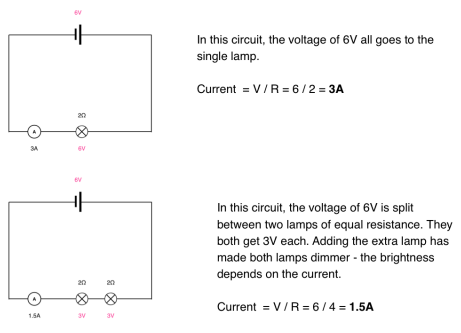
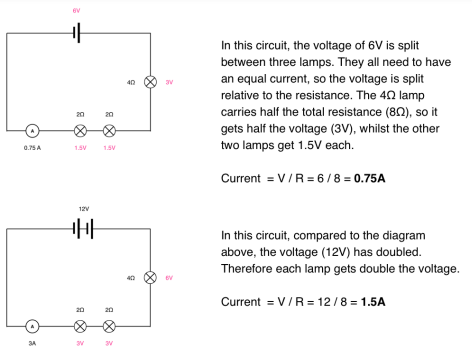

Parallel Circuits
- The voltage is the same for all components. In series circuits the voltage was shared between the components (in proportion of their resistance). In parallel circuits, every single component gets the full, maximum voltage. Therefore bulbs in parallel will have the same brightness (assuming equal resistance).
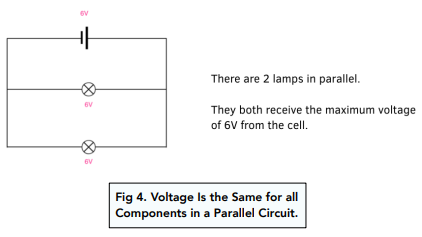
- The current is split between the branches of the circuit. The sum of the currents of all branches is equal to the total current that flows from the cell / battery. In other words, the total current through the whole circuit is the sum of the currents through the separate components.
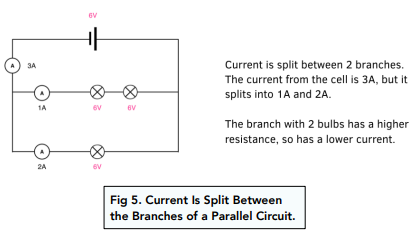
- A break in one component does not ruin the whole circuit. There is more than one route for charge, so if one lamp in a parallel circuit is broken, only the lamps in the broken branch are affected. Lighting in houses is often connected in parallel because it means that we can control different branches of the circuit (representing different rooms) using different switches.

- Total resistance is worked out using the reciprocal of the resistances of each branch. If there are 3 branches to the circuit (R1 – R3), then 1 / Total Resistance = 1 / R1 + 1 / R2 + 1 / R3. This means that the total resistance of two resistors is less than the resistance of the smallest individual resistor.

Where:
- Resistance, R, in ohms, Ω
Resistors
- Resistors in series increase resistance. In a series circuit, adding resistors will increase resistance. The current is the same in every single component in the circuit, so the more resistors we add, the harder it is for current to flow. This means that the overall resistance has increased in a series circuit.
- The more resistors added, the harder it is for current to flow.
- Resistors in parallel decrease resistance. In a parallel circuit, adding resistors will decrease the resistance. The potential difference is the same in every single component in the circuit. The more resistors we add in parallel, the more ‘pathways’ the current has to go through, so it is easier for current to flow through the circuit. This means that the overall resistance has decreased in the circuit. The more resistors added, the easier it is for current to flow through many pathways.
- The more resistors added, the easier it is for current to flow through many pathways.
Calculating Resistance in Series
For AQA Exams, we need to be able to calculate the combined resistance, also called the equivalent resistance, of resistors. You only need to be able to do this for resistors in series – resistors in parallel will not be tested.
Question: In the diagram below, there are two resistors in series. R1 has a value of 20 ohms, whilst R2 has a resistance of 10 ohms. Find the equivalent resistance of the two resistors.

We need to remember that the equivalent resistance simply means the total of the resistors in the circuit.
R total = R1 + R2
R total = 20 + 10
R total = 30 Ohms
Summary Comparison: Series vs. Parallel Circuits


Investigating Resistance in Experiments
Experiments with Series Circuits
For AQA exams, we need to design and use dc series circuits. We can use these circuits to investigate resistors.
Method:
- Set up circuit. We have to set up a circuit with a cell (battery), an ammeter and a resistor in series.
- Check the circuit. Make sure that the circuit is complete and working.
- Measure PD. Record the potential difference of the cell, in volts.
- Measure current. Measure the current in the circuit using an ammeter, recording the value in amps.
- Calculate resistance. Calculate the resistance in the circuit, by rearranging V = IR. Record the value for resistance in ohms.
- Change quantity of resistors. Add another resistor to the circuit and then repeat steps 2-5.
- Fill in a table. The results table should look something like this:

Experiments with Parallel Circuits
You can also investigate resistors in parallel. The experimental process is largely the same.
The AQA specification doesn’t require you to explain an experiment to investigate resistance in parallel, but this doesn’t mean they can’t give you a scenario with the experiment. In other words, they can’t have a 6 mark question asking you to ‘design an experiment to investigate resistance in parallel’ (like they can for series), but questions can have a scenario with an experimental set up explained to you.
In exams, this is an example of application questions. You should have learnt the experimental set up for series, so they want to see you apply your same knowledge to a less familiar scenario (in parallel)
Short Circuits

Current likes to take the easiest path with the least resistance. In this diagram, if switches P and Q are closed in this circuit, then neither lamps will be lit. The current prefers to pass through plain wire than the lamps, because plain wire has a lower resistance. Therefore a short circuit is formed.
When the switches are open, the current is forced to go through the bulb, and so the bulb lights up.
For this kind of circuit, there is no parallel split in current. If the plain wire path is available, then all of the current will go down that pathway.
Practice Electricity Questions
Practice Question 1
This diagram shows a parallel circuit. The current flowing through the 20 Ω resistor is 0.3A. Work out the current flowing through the 10 Ω and the total voltage of the cell.

The resistance through the 10 Ohm resistor is half of the 20 Ohm
resistor, so current is double = 0.6A. V = IR.
Looking at one branch, V = 0.3 X 20 = 6V
Practice Question 2
This diagram shows a circuit with two identical lamps. Each lamp has a resistance of 3 Ω and the cell is supplying a voltage of 12 V.

- When switch P is closed and Q is open, the current in the circuit is 2A and only Lamp B is lit.
- When switches P and Q are both open, the current in the circuit is 2A and both lamps are lit.
- When switch Q is closed and P is open, the current in the circuit is 4A and only Lamp A is lit.
- When switches P and Q are both closed, neither lamp is lit.
Which of the following statements is / are correct?
- False – I = V / R = 12 / 3 = 4A
- True – I = V / R = 12 / 6 = 2A
- True – I = V / R = 12 / 3 = 4A
- True – a short circuit is formed.
Practice Question 3
Which of the following is a unit of voltage?
- ampere / ohm
- (coulomb x ohm) / second
- coulomb / second
- (second x coulomb) / ohm
- ohm / volt
- coulomb / joule
Current = Charge / Time
Voltage = Current x Resistance Substitute current in the V=IR formula.
Practice Question 4
Below are five statements about parallel circuits. Select which statements are false.
- Each branch of a parallel circuit receives the maximum cell voltage.
- Within a branch of a parallel circuit, the current is always the same.
- In a parallel circuit with multiple bulbs, if one breaks none of the other bulbs will be affected.
- The total resistance in parallel circuits is the sum of the individual resistances of all components.
- True – in a parallel circuit the voltage is not shared, in contrast to a series circuit. Each branch gets the maximum voltage.
- True – each branch of a parallel circuit acts like its own mini series circuit. Different branches can have different currents, but within each branch the current is constant.
- False – this is incorrect, because only the bulbs in the same branch are affected. In a series circuit, in contrast, one broken lamp affects all the lamps.
- False – This is incorrect, as the reciprocal of the resistance is the sum of the reciprocals of the individual resistances.
Practice Question 5
The circuit below shows five lamps with identical resistance. Initially switch Q is closed.
Switch Q is now opened. Compared with the brightness from before (when Switch Q was closed), how has the brightness of the four lamps changed?


The correct answer is F.
When Switch Q is closed, the current bypasses A, B, D and E. The pathway through Q is the path of least resistance. The resistance in the circuit is quite low, because only lamp C is involved. This is a series circuit in effect. Therefore lamp C is very bright.
When Switch Q is open, the current is now split between the three branches of the circuit like a normal parallel circuit. All the lamps become lit. A, B, D and E are brighter than before as they now receive current. C is dimmer than before, because the total resistance in the circuit is higher as there are many lamps involved (you don’t need to do a calculation – if more lamps are involved, the resistance will inevitably be higher).
An electrical circuit is a closed loop of electrical components through which electric current flows. A circuit must have a source of electrical energy, such as a battery, and a complete path for the current to flow.
A series circuit is an electrical circuit in which the components are connected in a single path, so the current flows through each component in turn. In a series circuit, the current is the same throughout the circuit.
In a series circuit, the total resistance is equal to the sum of the individual resistances. This means that the current flowing through the circuit is limited by the total resistance, and the voltage across each component is proportional to its resistance.
A parallel circuit is an electrical circuit in which the components are connected in parallel branches, so that the current can flow through each branch independently. In a parallel circuit, the voltage across each component is the same.
In a parallel circuit, the total resistance is equal to the reciprocal of the sum of the reciprocals of the individual resistances. This means that the current flowing through the circuit is divided among the branches, and the total resistance decreases as the number of branches increases.
The main difference between series and parallel circuits is the way that the components are connected and the distribution of current and voltage throughout the circuit. In series circuits, the current is the same throughout the circuit and the total resistance is equal to the sum of the individual resistances. In parallel circuits, the voltage across each component is the same and the total resistance decreases as the number of branches increases.
Understanding series and parallel circuits is important because they are fundamental concepts in electricity and are used in a wide range of electrical systems, from household wiring to large power grids. Understanding how these circuits behave and how to analyze them is an important part of physics and electrical engineering.






Still got a question? Leave a comment
Leave a comment